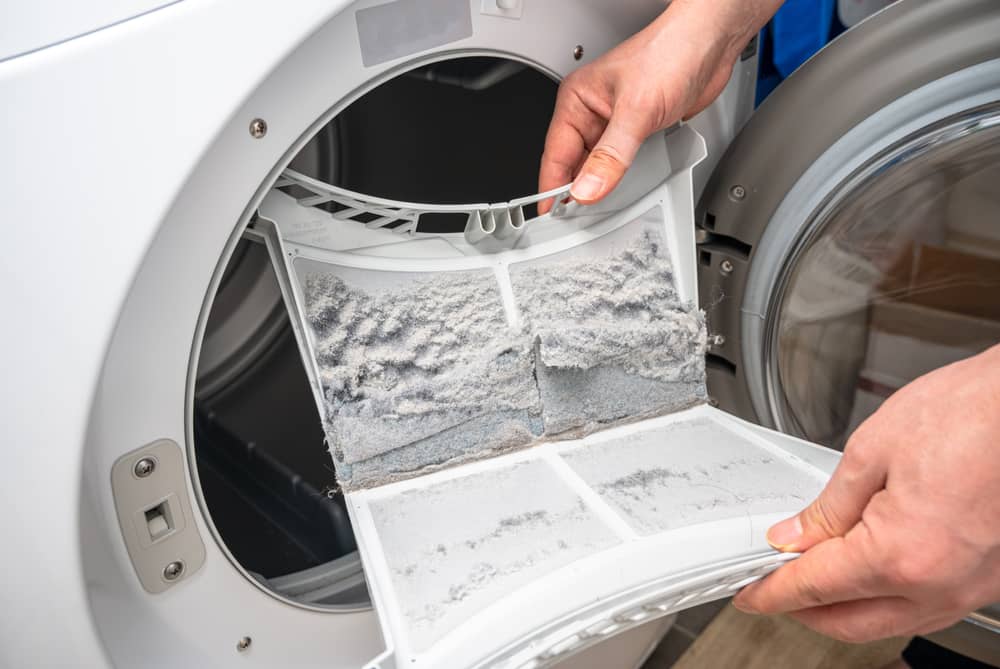Your dryer only tumbles freshly washed clothes, so does it really need cleaning?
Absolutely!
Skipping this chore isn’t an option. It’s a must to avoid fire hazards and keep your dryer running perfectly.
To clean your dryer, get all the lint out, wipe all surfaces, and tackle the vents.
Roll up your sleeves — we’ll share all the best ways to keep your dryer spotless!
Dryer Cleaning Schedule | Safety Tips | Materials You Need | Cleaning All Dryer Parts | Cleaning Different Dryers | Removing Stains | Tips To Keep It Clean
Why Clean Your Dryer?
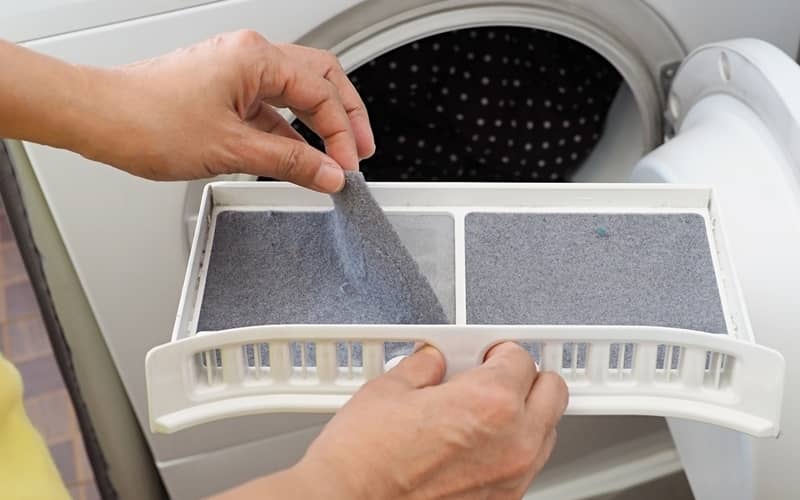
Lint is the number one culprit behind dryer fires, so cleaning is a safety must!
Beyond that, let’s not forget that dryers work hard to tumble everything – from clothes to hefty sheets.
Over time, they collect dirt, lint, and waxy residue that block airflow.
A good clean is essential for dryer maintenance, helping your dryer last for decades!
How Often Should You Clean Your Dryer?
Apart from cleaning the lint filter after each use, there’s no strict rule for how often to clean your dryer. It all depends on how much you use it.
However, we compiled this handy schedule to guide you:
- As needed: Tackle spots and stains.
- After each cycle: Clean the lint screen and empty the water tank (for ventless dryers).
- Fortnightly: Wipe the door and underneath the seal. Brush the lint trap slot and other filters.
- Quarterly: Wipe down the drum and exterior surfaces.
- Yearly: Deep clean the dryer vents and duct system.
If you’re struggling to keep up, professional house cleaners can give your dryer a thorough wipe-down. They can also run a laundry load or two for you!
Before Cleaning Your Dryer
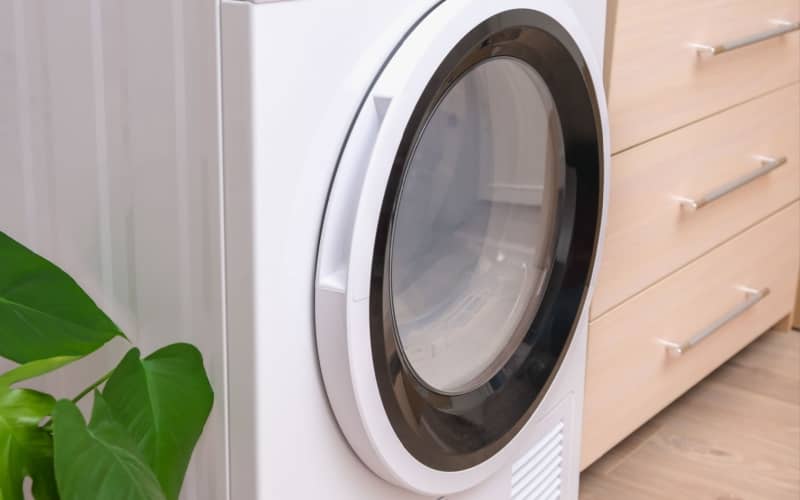
Before you battle that lint, take a moment to prep for safety.
First, unplug the dryer or disconnect the gas line for gas dryers.
If you’re tackling the dryer vents yourself, wear a dust mask!
Also, be cautious about flammable cleaners. Always check the product labels to be sure.
As you clean, collect lint in a non-flammable container or dispose of it right away to avoid fire risks.
When in doubt, turn to your dryer’s manual. Check it for special cleaning settings you can run!
Materials You Need For Cleaning Your Dryer
Cleaning your dryer doesn’t require fancy tools.
Here’s what you’ll need:
- Warm water
- A microfibre cloth or soft towel
- A dryer cleaning brush or any soft-bristled brush
- Dish soap or a gentle all-purpose cleaning solution
- A vacuum cleaner with a crevice or hose attachment
Let’s start!
How To Clean Every Part Of Your Dryer
Deep clean your dryer by checking every nook and corner for dust, lint, and mould. Here’s how.
How to clean a dryer drum
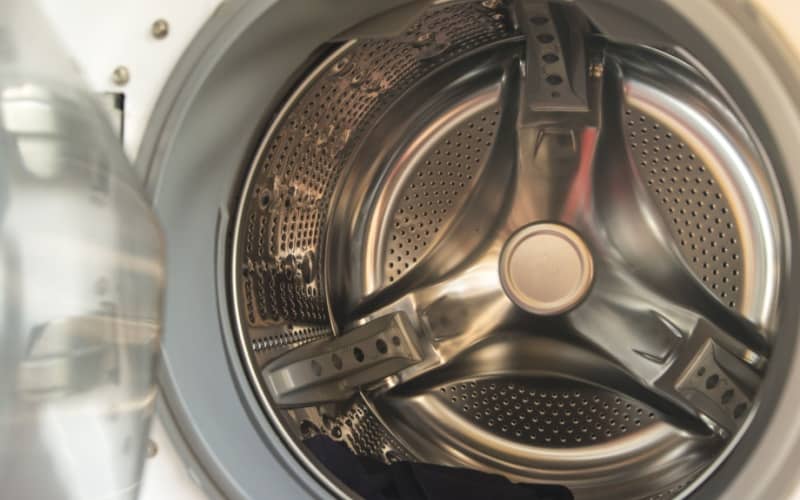
The dryer drum is where clothes are placed, so it’s particularly prone to residue and stains.
To start cleaning the dryer drum, vacuum out any dust.
Mix some dish soap with warm water, dampen a soft cloth, and wipe down the interior thoroughly.
Let the drum air-dry by leaving the door open, or run an empty load to dry it completely.
Aim to clean the dryer drum every 3-6 months.
How to clean a dryer lint trap
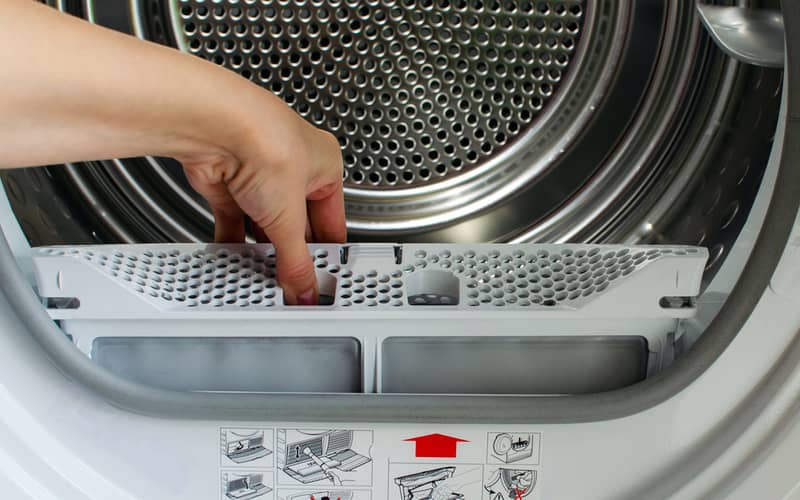
First, locate the lint trap — usually near the dryer door — and pull it out.
If you clean this part regularly, scraping off the lint by hand should be easy. Wash the screen with soapy water and rinse thoroughly.
For stubborn buildup, scrub the dryer lint screen with a soft brush and diluted dish soap.
Also, check the slot where the lint trap goes in — lint can find its way down there!
Use a thin, long-handled brush or a vacuum cleaner with a slim nozzle to suck out the remaining lint.
Lint is highly flammable, so clean the lint trap after each use!
Meanwhile, deep clean the lint trap slot every fortnight to avoid fires and keep your dryer in top shape.
How to clean a dryer vent
Clean your dryer vent yearly to keep air flowing freely.
To start, pull the dryer away from the wall and unscrew the vent hose clamps.
Vacuum and brush the duct system on the wall from inside and outside your home.
Also, clean the vent hose and the vent on the dryer itself.
Reattach everything once cleaned, and run an empty cycle to make sure it’s all working.
For more detailed instructions, check out our dryer vent cleaning guide!
Tip: If the task feels overwhelming, don’t hesitate to call an HVAC professional. If you decide to do it yourself, be sure to put on a dust mask!
How to clean a dryer door
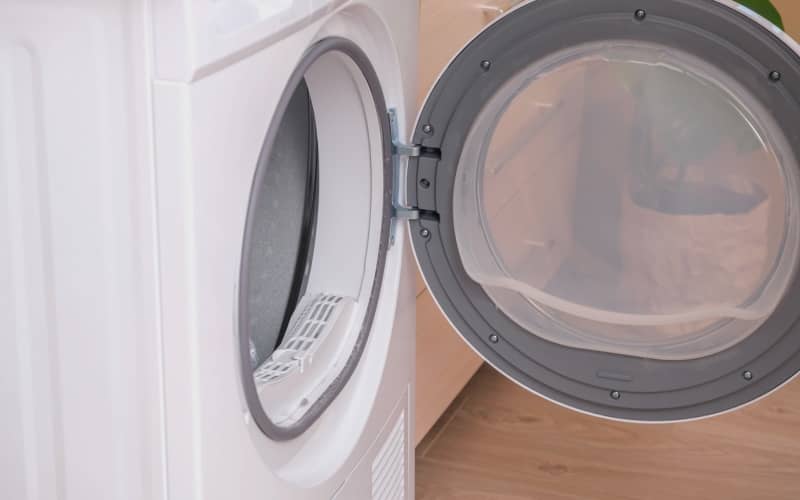
To clean the dryer door, wipe it down with a damp cloth and soapy water.
Don’t skip the door seal — the rubber strip that keeps the door tight. It’s mould’s favourite hideout and a culprit of bad smells!
Gently pull back the rubber strip to clean underneath.
Use a soft cloth and a non-abrasive solution like a diluted dish soap or a gentle all-purpose cleaner.
Finally, leave the door slightly open to let everything dry completely.
Clean the door seal every 2 weeks, and wipe down the door every 3-6 months.
How to clean the exterior of a dryer
Clean the exterior of your dryer to keep dirt out of its openings.
Wipe the surfaces and control panel with a damp cloth, but be careful not to soak the knobs and buttons.
For that extra sparkle, try a glass cleaner on the door.
Don’t forget to clean behind and under the dryer — lint and dust tend to gather there.
A quick wipe every 2 weeks and a deeper clean every 3-6 months will keep your dryer looking sleek!
Cleaning Different Types of Dryers

Regardless of the dryer type, the key areas to clean are the door and rubber seal, drum, lint trap, and exterior surfaces.
However, different dryer models — vented, heat pump, or washer-dryer combos — have their cleaning quirks.
Here’s how to keep yours pristine and running smoothly!
How to clean a vented dryer
Extra parts to clean: dryer vent hose and duct system
For vented dryers, keep the vent hose and duct system lint-free.
Before cleaning, turn off the gas supply and disconnect the gas line for your safety!
If you have a gas dryer, skip flammable cleaners like vinegar and rubbing alcohol!
Dish soap is safe, but always check the safety label on other cleaners to be sure.
How to clean a condenser dryer
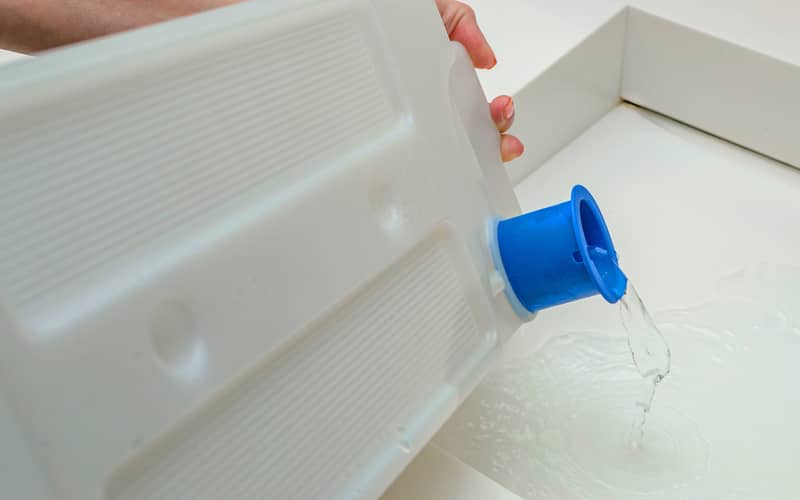
Extra parts to clean: condenser unit and water tank
A condenser dryer is ventless, so no vent cleaning is needed!
Some condenser dryers collect water in a tank — empty this after every use. Gently scour it with soapy water if you notice any scaling.
Next, locate the condenser unit — usually at the bottom behind a panel. Take it out every 3 months for deep cleaning.
If there’s too much lint in there, scrape it off by hand. Then use a brush and soapy water to clear the rest.
Wipe the condenser unit with a damp cloth, and let it dry before putting it back in.
How to clean a heat pump dryer
Extra parts to clean: base filter, heat exchanger, and water tank
Heat pump dryers are ventless, so you only need to check the water tank. Be sure to empty this after each use.
They also have a second lint filter, usually at the base. Clean this monthly with a soft-bristle brush and soapy water.
Lastly, don’t forget the heat exchanger! You’ll usually find it behind the base filter.
Most models have an indicator light to remind you to clean the heat exchanger coils, but brushing them monthly is a good habit.
How to clean a washer-dryer combo
Extra parts to clean: detergent tray, vent hose, and water tank
To keep your washer-dryer clean, empty the water tank after every cycle.
Also, clean the detergent tray weekly. Soak it in warm, soapy water for 10-15 minutes, scrub any residue, and dry before popping it back in.
Some models may have a vent hose — check this for lint buildup every fortnight to prevent clogging.
How to clean a drying cabinet
Extra parts to clean: hanging rods, shelves, and vents
Drying cabinets are a lifesaver for items you’d never toss in a tumble dryer, like delicate fabrics, gloves, and shoes.
To clean a drying cabinet, wipe down the hanging rods, shelves, and trays with a mild cleaner. This helps prevent water spots and mould.
And while they don’t spin clothes, lint could still build up. Check the interior and vents often and vacuum out the dirt.
Cleaning Common Dryer Stains
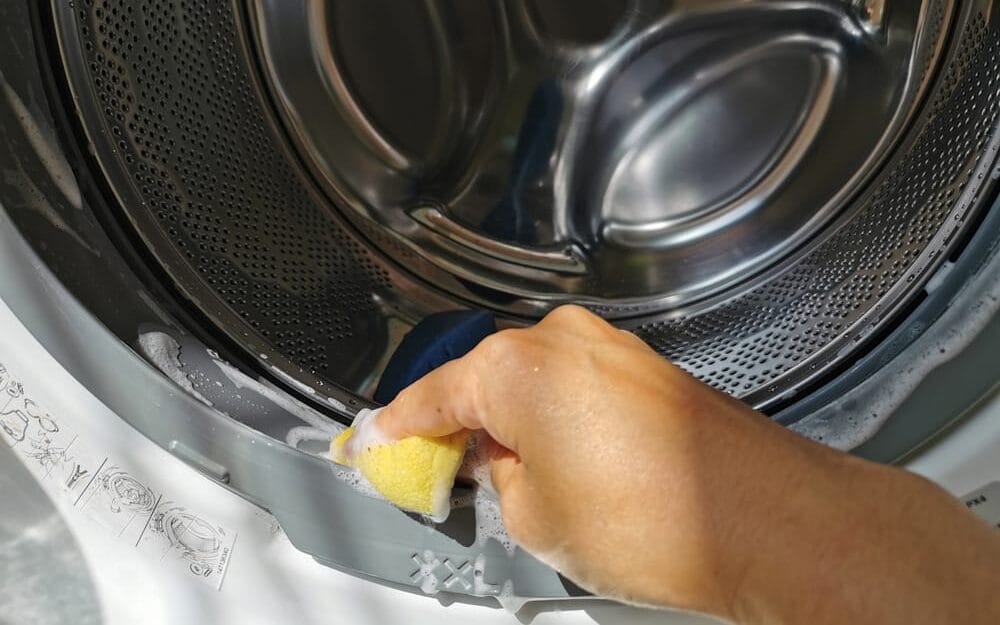
Besides clothes, dryers sometimes encounter ink, lipstick, or the dreaded gum!
Before tackling these stains, always spot test your cleaning solutions first.
Crayon, food, or lipstick stains
Scrape off as much debris as you can with a plastic scraper or a silicone spatula.
Anything plastic could work — just avoid sharp objects like knives that could scratch the dryer.
Lightly scrub any remaining stain with a dish soap and warm water mix.
If that doesn’t do the trick, apply a baking soda paste on the stain. Let it sit for 10-15 minutes and wipe away!
Gum stains
Got gum in your dryer? No worries — harden it first with ice, then scrape it off.
If that doesn’t work, soften it with a blow dryer and wipe it away.
Gently scrub any leftover residue with warm, soapy water.
Ink stains
Start by running an empty cycle for 10-15 minutes to loosen the ink.
Once done, unplug the dryer (or disconnect the gas line if it’s a gas dryer).
For electric dryers, dip a cloth in rubbing alcohol and gently rub the ink stains until they lift.
For gas dryers, try a non-flammable solution like diluted oxygen bleach. Let it sit for 10-15 minutes before wiping it off.
Toss an old white towel in a cycle to check for ink transfers. If it comes out clean, you’re good to go!
Rust stains
Apply a thick baking soda paste on the rust stains. Let it sit for 2-3 hours, then scrub the area with a soft sponge.
If needed, grab a rust remover from your local hardware store. Be sure to follow the product instructions.
Don’t forget to wipe off any residue!
Keeping Your Dryer Cleaner For Longer
Clean the lint trap after every load to stay ahead of lint buildup and avoid clogging up the dryer vents.
Always check your clothes’ pockets before drying (and washing!) to keep foreign objects from sneaking in.
If you use dryer sheets, consider switching to residue-free alternatives like wool dryer balls.
Lastly, keep your laundry room tidy by wiping down your washing machine and other nearby objects often.
This reduces the amount of dirt that could sneak into your dryer.
Dryer Cleaning FAQs
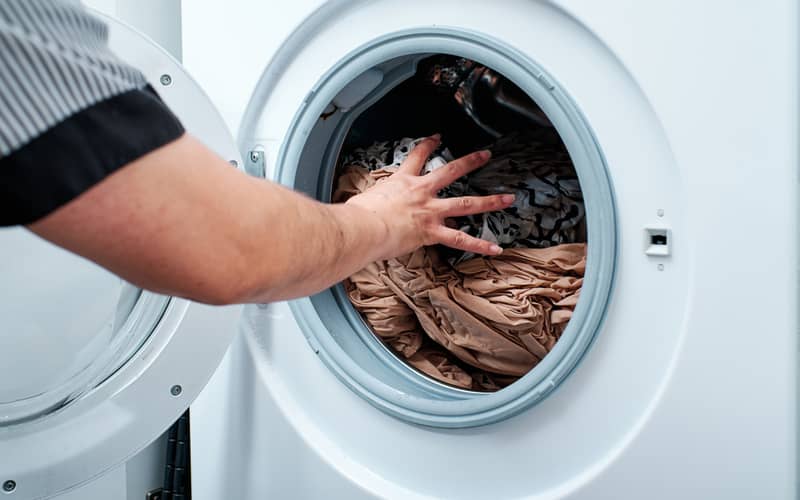
Dealing with stubborn lint or strange smells? We’ve got you covered!
Can you deep clean a dryer on your own?
Yes, you can deep clean a dryer by yourself.
However, if you have a vented dryer, it’s best to get help when moving it away from the wall to check the vent hose and duct system.
If you don’t have access to the exterior dryer vent, consider consulting with an HVAC professional.
How do you clean a dryer that smells?
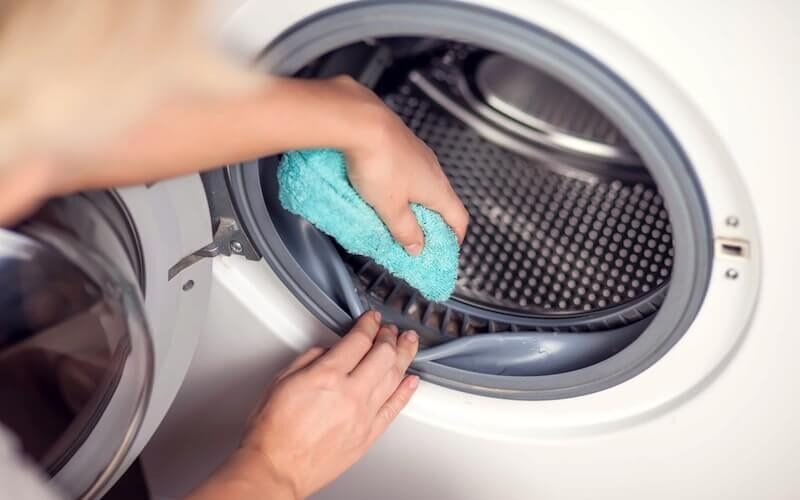
A funky smell in your dryer often means poor airflow. Fix this by deep cleaning your dryer inside and out.
Clean the lint trap, filters, and vent system. If your dryer has a water tank, empty and scrub it.
Also, check under the door seal! This is a favourite hideout of mould and mildew.
Banish any lingering odour by wiping with a soft cloth dipped in any of the following ingredients:
- Baking soda paste
- Gentle all-purpose cleaner
- Dish soap mixed in warm water
You can also use diluted vinegar, but avoid it on gas models as it may be flammable.
Finally, run an empty dryer cycle and check if the smell has gone away!
Is vinegar flammable in a dryer?
Yes, vinegar can be flammable. To be safe, avoid using it when cleaning a gas dryer.
Instead, opt for dish soap or any mild all-purpose cleaner. Just be sure to check the product label first!
How do you sanitise a dryer?
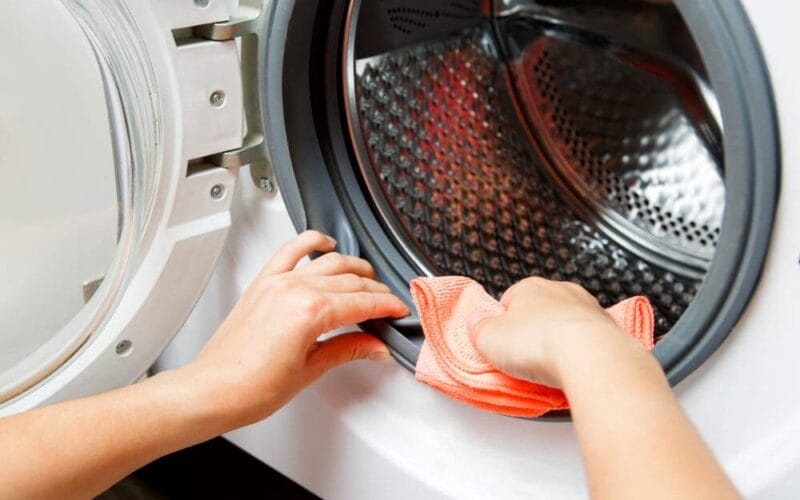
To fully sanitise a dryer, deep clean these parts:
- Lint trap and its compartment
- Water tank (for ventless dryers)
- Any secondary lint filters
- Door and door seal
- Dryer drum
- Exterior surfaces
- Vent system
Use a soft-bristle brush to clean the lint trap. Then vacuum inside the lint trap compartment.
Wipe down the surfaces with a cloth dampened with a mix of warm water and dish soap or a gentle all-purpose cleaner.
Lastly, clean the dryer vent with a long-handled brush and a vacuum with a hose attachment.
Why does my dryer smell like it’s burning?
If you notice a burning smell from your dryer, unplug it or disconnect it from the gas line right away.
This burning funk is usually caused by lint buildup, which restricts airflow and causes overheating.
It could also be due to a worn-out belt or motor. To be sure and safe, call a professional to inspect the dryer for any issues.
Why are my clothes still damp after a dryer cycle?
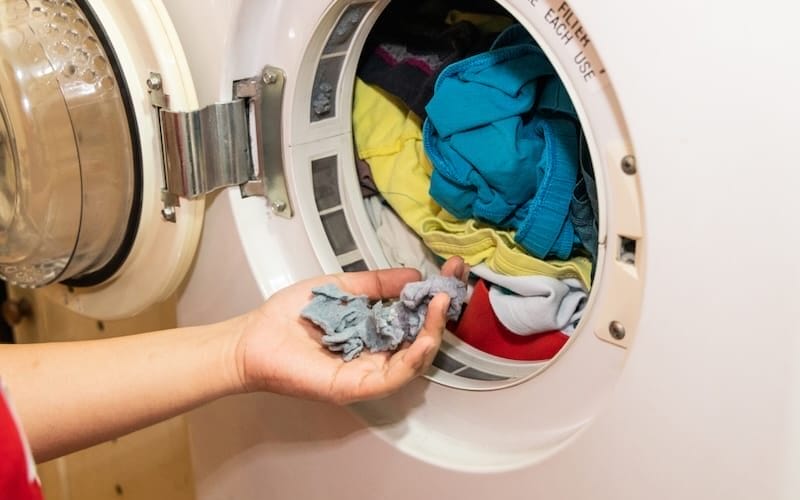
Either you overstuffed your dryer, or something — probably the lint trap or vent — is clogged.
Check your dryer for lint buildup that could block airflow.
If lint isn’t the culprit, you probably hit the wrong dryer settings.
If nothing else clicks, contact a repair technician to help with any mechanical issues.

